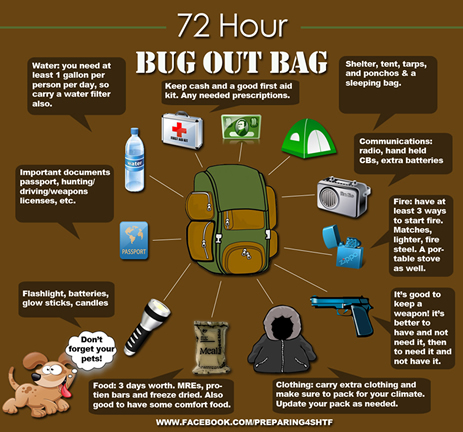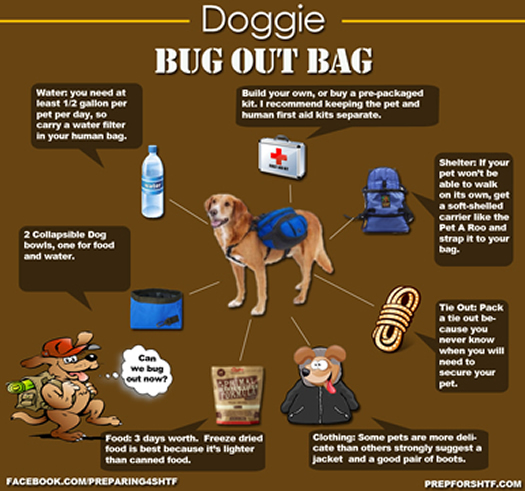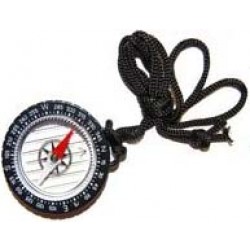Evacuation with a Bug-Out Bag
If you are forced to evacuate, a bug-out bag (or 72 hour kit) is important. A bug-out bag's focus is on evacuation, rather than long-term survival. This will get you through a couple of days in a temporary shelter until you can return home.
The contents of a bug-out bag might include:
- Enough food and water to last for 3 days. This includes:Water for washing, drinking and cooking (about a gallon of water per person), non-perishable food that is lightweight, water purification supplies, simple cooking supplies

- A first aid kit
- Fire starting tool
- Maps and travel information
- Camping equipment, including sanitation supplies
- Medical records
- Pet, child, and elderly care needs
- Complete Identification (drivers' license, etc.)
- Fixed-blade and folding knife
- Duct Tape and rope/paracord
- Weather appropriate clothing
- Plastic tarps for shelter and water collection
- Sleeping bags
- Enough medicine to last an extended evacuation period
- Slingshot, pellet gun, blowgun or other small game hunting equipment
- Wire for binding and animal traps
- Battery or crank operated radio
- Lighting (battery or crank operated)
- Firearms and appropriate ammunition
- Cash and change, as electronic banking transactions may not be available
- A disaster plan (emergency centers, routes, meet-up locations)
- Professional emergency literature explaining what to do in various types of disasters (read this beforehand)
The world is in chaos, where do you go?
Many people already have determined where they would go – a bug out location – a spot where they could lay low and live for a while if things got pretty bad. If you haven’t decided where you’d go during an emergency, there are some things to take into consideration.
1. How far away?
How far away is your bug out location going to be from your home? Depending on the disaster that is likely to happen, you'll want that location within a tank of gas of home. Fuel may not be available so being able to get there on a tank of gas in your bug-out vehicle is important.
2. What kind of shelter?
Ideally you are planning to go to your own property. There is no guarantee that public lands will have space (or allow you in). If you expect to squat on private land, you are risking the owner defending his property (and he has every right to). Your best bet is to at least buy some property out in the country, preferably with few dwellings around. Wooded is even better or at least a landscape that gives you either cover or view of the surrounding area. I would suggest putting a small trailer or tiny home there - that way you won't have to tow your "living quarters" with you through possible bad roadways destroyed by flood or earthquake, riots, or other obstacles. You can move faster if you aren't towing something.
Tiny houses are inexpensive, you can build them yourself, are mobile and make great bug-out cabins.
3. Do you have a emergency bag?
We've covered what should be in your bug-out bag. Depending on what are you’re in, your emergency items might differ. For example, if your bug out location is right next to a river, you might want a water filter instead of large water containers. A battery operated radio vs. a crank radio....
4. Water
Will you have water access during an emergency. If man-made water sources aren't’t working, you might need to choose a location that has it’s own natural water source. A location close to a lake, river, stream or natural well. You’ll also need to consider how susceptible those sources are to contamination and have filters and a way of transporting that water if you intend to use it.
5. Nearby food
While you may have storage of food, eventually that can run out. Depending on how long you plan on staying at your bug out location, food might be a major consideration. Are you going to have enough animal or plant life around you that you can just live off the land? Are you going to be packing in all your food? Is the ground suitable for planting? Are there farms nearby you might barter with? Don't wait till the emergency to get to know your neighbors.
6. Popular for other people
Invariably other people will want to bug out to similar locations. It may get very crowded at your typical vacation location. Regardless of where you go, there will be neighbors. It's a good idea to get to know the current residents in the area - it's not a good idea to be the 'new guy' so you'll want to establish friendly relationships with the year-round residents. You'll also want a way of defending yourself if things spin out of control or someone tries to take advantage of your stockpile.
7. How are you going to get there?
I really don't think any suitable bug out location is going to be reached by bike or walking in most cases. A vehicle such as a motorcycle or small car will give you the best mobility and safety. Make sure to keep the gas tank full. If you do decide to walk or ride a bike, be armed. You will be an easy target so make sure you take back roads where you won't be as easily noticed - especially if you are carrying lots of gear.
8. How many people are you planning for?
This is probably one of the first things you’ll need to determine because it has a huge effect on your food storage, water storage and other emergency supplies. Plan for a certain number of people and stick to it. You will probably let others in, in time anyway, but to do that you have to plan for extra mouths NOW. If you think you'll need one of something, plan for two.
9. Communication
Odds are when the SHTF cell phones won't work, TV won't work, the grid will go down, and communications will be controlled. You may want to put away a set of walkie-talkies and a portable short wave so that you can keep in contact and know what is going on. Look into making a faraday cage as an electromagnetic pulse can destroy all the equipment you've stored.
10. Medical Care
Knowing what you'll need is always a difficult call. First get a supply of necessary medicines you use daily. Second get medicines for cuts, bruises, colds, flu and gunshot wounds. Finally, you'll want items to stop excessive bleeding, to protect you in a pandemic, and even simple surgery tools if you have the skills to use them or are including someone in your bug out location that does.
11. Best Bug out locations
The best bug out locations are far enough from civilization, but still having an infrastructure. Farm land in a farming area is a good choice - especially since food can and will be produced there. Basically stay away form any major urban area. Far away!
- Where to Go
deally, you're already living where you plan to be when the SHTF. Unfortunately, the best place to be for SHTF is not where the jobs typically are - in the city or suburbs. In that situation, or if you are on the coast, in an earthquake zone, or some other place not suitable to stay, you'll need a safe house or survival retreat in a location where the current crisis will not threaten you. Ideally, you may want to coordinate with family and find a place 100-150 miles from where you are now. Too far, and your location will be difficult or impossible to get to. Consider that if you are on the shore, find somewhere inland on higher ground. If in the city, a country location is better. This gives you options. Where to go? Try these.... 
- Rivers Swamps and Islands of the Gulf Coast
- Islands & Lowlands of the Atlantic Coast
- The Appalachian Mountain Corridor
- Lakes & Big Woods of the North
- The Midwest & Heartland
- Wilderness Strongholds of the Rocky Mountains
- Deserts, Canyons, and Mountains of the Southwest
- Pacific Crest Mountains and the West Coast
- Whatever disaster you are facing should not affect your bug out location, and vice versa.
- You'll have somewhere safe to GO. You won't just be leaving blindly without a destination in mind.
- You must be able to get there on one tank of gas, even if there is a great deal of traffic or you must take slower, more roundabout back roads.
- You can't count on finding a hotel - they will all likely be filled if the disaster is large enough.
Bring a few changes of clothes, a toiletries kit, necessary prescription drugs, ammunition, food or anything else you might need. Don't forget pets too - they'll need crates (folding ones are great if space is a problem) to keep them apart from other family pets if they aren't used to each other.
For most people, a friend or relative's house is the easiest and most cost-effective safe house. However, we all prefer to have control of our own situation so the ultimate safe house or survival retreat would be a second residence located in a very rural location. This can double as your vacation home, hunting lodge or weekend getaway destination. If this is feasible, or if you are looking for a vacation home - why not make it do double duty...make sure it is:
- Seclusion will offer you the best protection.
- Keep it simple or it may become a target for vandalism.
- If it's not near a spring, well, stream or other natural source of water, you'll need a generator and extra fuel or a hand pump to get water out of a well..
- Has a working wood fireplace or wood stove for cooking and heat.
- Near a village or small town where you can go (by foot, if necessary) for supplies, news and contact with the others should the emergency be of lasting duration.
- Enough land for crops and a large garden.
- Near a natural food source (hunting, fishing)
- Enough food stored at the location for a year - minimum 3 or 4 months.
- Tools available for long term self-suffency.
- Weapons and ammunition to defend your location from mauraders.
- Make sure whatever vehicle you use to get there has room for your family and the supplies you plan to take.
Courses in Self-Defense and Survival

This course focuses on common sense, real world proven skills and knowledge that account for the reality of duress, stress and confusion in real survival situations.

Self defense, close combat, martial arts, pressure points, krav maga, muay thai, fitness, MMA, fight, combat, kungfu, pe

This course will teach the key elements of how to survival urban environments. stay or leave, Home Survival Shelters, Terrorist Attack, Government/Economic Collapse, 72 hour Bug-out Bag, post-disaster world and More...

How to navigate using a magnetic compass and topography as well as other old-school survival techniques. Make and use simple traps and weapons such as snares, fishing spears and blow guns. Construct simple, primitive shelters. Purify water. Start a fire.

Using natural remedies for health and dog training

This course focuses on common sense, real world proven skills and knowledge that account for the reality of duress, stress and confusion in real survival situations. Learn the key elements to urban survival. Preparing for emergency. Urban survival hacks. Living in a post-disaster world

Build confidence in working with highly beneficial plants. Identify the most common and useful medicinal plants. Understand how to harvest plants for the greatest effectiveness. Understand how to use plants for ultimate health and wellbeing.



















